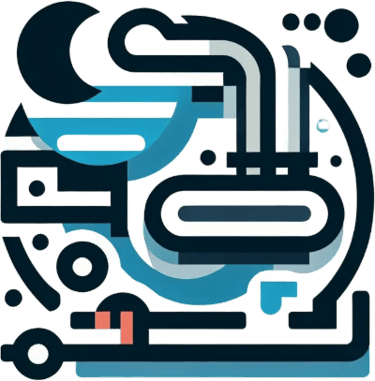The Great Divide: Mastering Onshore vs. Offshore Plot Plan Layout in Piping Design
ACTIVISM


When you look at a massive industrial facility like a refinery or a gas processing plant, it’s easy to see it as one giant, interconnected machine. But for the piping designers and engineers who bring these projects to life, one of the most critical early decisions is where to draw a literal and figurative line: the division between the onshore and offshore portions of the plot plan.
This split isn't just an organizational preference; it's a fundamental design principle driven by vastly different environmental conditions, construction methods, safety requirements, and logistical challenges. Getting this division right is key to a project's success. Let's break down why this separation is so crucial and what factors dictate its layout.
First, What Are We Dividing?
In projects like offshore oil and gas production or liquified natural gas (LNG) terminals, the overall facility is split:
Offshore Plot: This typically includes the offshore platform (wellhead, processing, quarters, etc.), subsea pipelines, and any floating production storage and offloading (FPSO) vessels. This is where the resource is extracted.
Onshore Plot: This is the land-based facility. It could be a receiving terminal, a gas treatment plant, a power station, or a tank farm. This is where the product is processed, stored, and prepared for transport to the market.
The connection between these two worlds is a pipeline—often called a feeder line or export pipeline—that runs along the seabed to the shore.
The "Why": Key Drivers for the Split
The division is dictated by a clash of two very different worlds.
1. Environmental and Load Conditions:
Offshore: Designs must account for harsh, unrelenting forces: hurricane-grade winds, massive wave loads, saltwater corrosion, and seismic activity. Equipment is more compact, robust, and often elevated to avoid wave impact. The plot plan is incredibly space-constrained, leading to vertical designs.
Onshore: While subject to weather, the forces are less extreme. The primary concerns are wind, rain, and temperature fluctuations. Space is (relatively) more available, allowing for a more horizontal, spread-out layout. Corrosion protection focuses on atmospheric conditions rather than constant saltwater immersion.
2. Safety and Risk Management:
Offshore: Escape is a major concern. The plot plan must include dedicated escape routes to lifeboats and helidecks. The risk of hydrocarbon release is compounded by the confined space, making fire and gas detection and suppression systems paramount. The layout is designed to minimize the chance of an incident escalating.
Onshore: While safety is always priority #1, evacuation routes are land-based. The plot plan uses safety distances (e.g., spacing between a flammable storage tank and a fired heater) to manage risk. The larger footprint allows for better segregation of hazardous and non-hazardous areas.
3. Construction and Maintenance:
Offshore: Modularization is king. Large sections of the platform are built in onshore fabrication yards, then transported by heavy-lift vessels and installed offshore. The plot plan must be designed in discrete, transportable modules with clear interfaces. Maintenance is a major challenge, requiring careful planning for crane access and component replacement.
Onshore: Construction is more straightforward, with direct access for cranes, trucks, and workers. Maintenance access is a key layout consideration, but it doesn't face the same logistical hurdles as an offshore platform.
4. Logistics and Personnel:
Offshore: Everything—from a spare bolt to drinking water—must be shipped or flown in. Personnel work on a rotational basis, living on the platform for weeks at a time. This necessitates accommodations (quarters), helidecks, and laydown areas for supplies.
Onshore: Logistics rely on roads and railways. Personnel go home at the end of the shift. The supporting infrastructure is entirely different.
The Interface Point: The Shore Approach
The most critical part of the entire plot plan layout is the transition point—the shore approach. This is where the subsea pipeline makes landfall. The design here is complex and must consider:
Environmental Protection: Minimizing disruption to coastal ecosystems, beaches, and dunes.
Geotechnical Stability: Ensuring the pipeline is stable and protected as it transitions from the seabed to underground on land.
Security and Access: This area often contains critical infrastructure like pipeline emergency shutdown (ESD) valves and must be secured.
Corrosion Management: This is a high-corrosion zone where different protection systems (offshore cathodic protection, onshore coatings) meet.
Best Practices for a Successful Layout Division
So, how do you manage this complex divide effectively?
Define the Battery Limits Early: Clearly establish the technical and contractual boundaries between the "Offshore" and "Onshore" scopes of work. This is often called the battery limit, typically at the first isolation valve onshore.
Integrated Design Teams: Foster constant communication between the offshore and onshore design teams. They cannot work in silos. The interface between the subsea pipeline engineers and the onshore pipeline/process engineers is vital.
Master the Interface Documents: Key documents like the Interface Management Plan and P&IDs (Piping and Instrumentation Diagrams) that cross the boundary must be meticulously controlled. A change on one side inevitably affects the other.
Plan for the Whole Lifecycle: Consider how the facility will be operated, inspected, and maintained for decades. Is the onshore plot laid out to easily receive fluids from the offshore source? Are there adequate provisions for pig launching/receiving to clean the pipeline?
